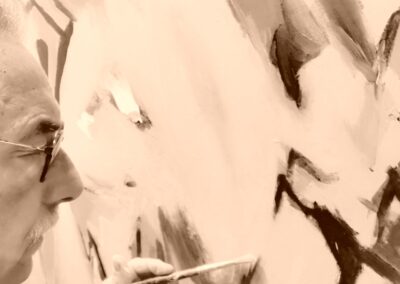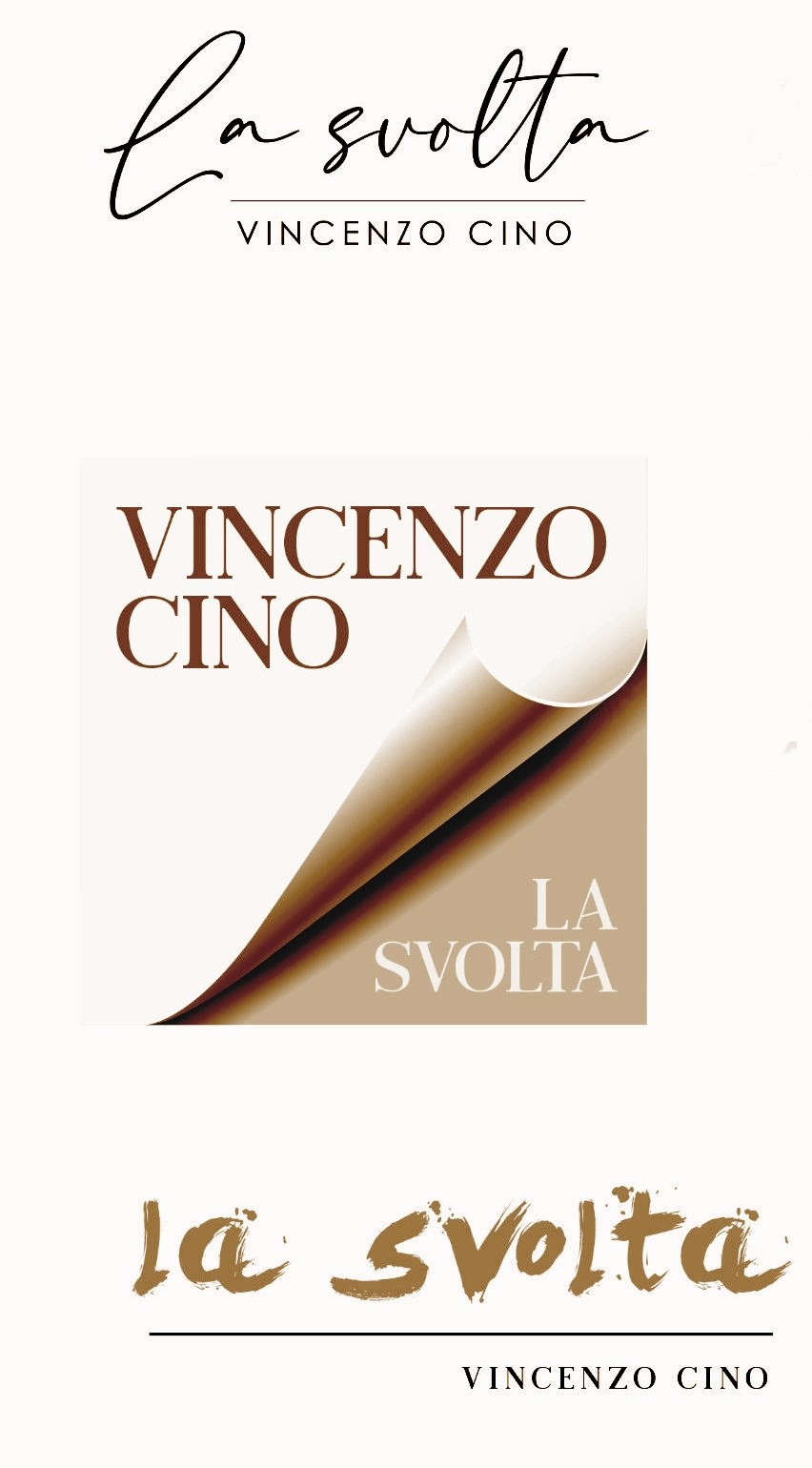My article
THE BREAKTHROUGH
“What would life be like if we didn’t have the courage to try something?”
(Vincent van Gogh)
The key to my artistic breakthrough is most likely to be found in a set of rediscovered values: the awareness of fully living the familiar passion for art, the determination to pursue one’s goals and the courage to experiment with new techniques and materials to create one’s own contemporaneity, in a process that has its emotions expressed through the pictorial act.

Criticisms
INTRODUCTION BY FRANCO CIPRIANO
Pictura activa
Enzo Cino’s artist experience relates to the singular and ‘necessary’ dimension of art.
CRITICAL ESSAY BY ANGELICA FALCONE
The artistic research of Vincenzo Cino, a painter who works between Naples and the Vesuvian area, comes with this exhibition to a change of direction, a “Turn”, in fact, born from the need for a stylistic transformation, a natural personal and professional evolution.
From the lyrical realism of his father’s inspiration, Cino initially develops an interest for the landscape and the land to which he belongs, arriving, however, in the years of maturity to a pictorial art that has nothing to do with the clarity of the figuration, nor does propose itself to represent on the canvas a reality that does not reflect his inner world.
The works on display are therefore the result of a revelation, an epiphany that has come to the end of a long and painful process of research and intimate analysis of the self: his works are real spiritual compositions that find points of reference in the currents of Abstractionism lyric and informal art.
The human figure and the landscape disappear and an idiosyncrasy towards every kind of form appears in its traditionally recognized and accepted definition.
In addition to the denial of a rational knowledge of reality, Cino preserves the instantaneity of the pictorial gesture of Informal art, the aim of which is to preserve the authenticity of inspiration and production.
There is no longer a protagonist of the work; on the contrary, the way in which the color spread on the canvas is perceived by the observer, builds the real subject, which is always an emotional subject. We are therefore faced with a participatory creation of the work of art starting from its compositional elements: color and matter.
The chromatic range is assorted and colorful: in most cases the artist prefers brighter, sanguine shades spread on canvas, jute, wood and cardboard with generous and impulsive brushstrokes, without excluding, at times, the ethereal and luminous ones. More frequently – not surprisingly – the shades of blue and red recur, to underline, perhaps unconsciously, the deep bond with one’s roots: the depths of the sea and the threatening power of Vesuvius.
The combination of non-shapes and colors is closely connected with the spiritual element in the artist, who makes Kandinsky’s lesson his own, seeking the direct expression of individual emotion. “Composition is more and more a force rather than the result of thoughts,” he says.
If art is therefore a revelation of the human soul, it will necessarily be constituted by the dialectical unity of opposites: sometimes aggressive and violent, sometimes poetic and sentimental.
The art of Vincenzo Cino encourages poetic wandering, the escape of the flaneur who, oppressed by the weight of reality, seeks refuge in an imaginative elsewhere made of contemplation of beauty, of expressive freedom, of clear and courageous manifestation of his own strength, as much as of his own fragility.
CRITICAL ESSAY BY LEONARDA ZAPPULLA
Vincenzo Cino was born in Portici. His father, also a painter, infuses in him a passion for art.
If for his father, a painter with a classicist matrix, the precision of the figuration was the cornerstone of his profession, on the contrary, for Vincenzo, the composition is the result of an inner drive. To put it in his words “the serenity, the spontaneity, the speed of the brush strokes, the arrangement of the spots and the choice of colors are nothing but a tool, the connection between the soul and the canvas”. The artist’s pictorial research is based on abstraction and fully respects the creative emotion.
The skilful union of form and color transmits a harmonic construct with strong poetic potential, a gestural language that evokes in some canvases a reminiscence of realistic spatiality and in others a very fine lyricism, free from any academic or formal constraint. Vincenzo Cino’s compositions are offered to the viewer as refined chromatic symphonies full of contrasts, capable of capturing the attention and carrying the observers to landscapes that can only be felt by the imagination, clear and honest emotional landscapes.
Arch. Fabrizia Cino
HWCD – Senior Interior Designer – London
“Vincenzo Cino’s works are a mixture of intuition and expression, with unpredictable colors, geometries and shapes. An awakening, an awareness of the strength of shapes and brushstrokes. The large scale of his works expresses those emotions that have no place in verbal language. The vivid and skilfully combined colors, together with the softness of the features invade the environment, making every single work the absolute protagonist of the space.”
Dott. Francesco Funghi
INFINITESIMAL- (P)ART
Dr.FRANCESCO FUNGHI
Historic and art critic and vault director | Art | Consuling
Naples is a city that overwhelms the senses. A territory where there are countless places, all seemingly similar, but if observed carefully and analysed in their deepest essence, they are completely different from each other. It’s a land that bewitches, enchants, pervades, and betrays. In Naples, nothing is straightforward, and to truly know it, one must live in it constantly, obeying the rules it imposes. The lights, the smells, and its noises don’t always fully reveal the true nature of the uncommon Neapolitan place.
Cino Vincenzo reflects this deeper essence. His artistic practice goes beyond the stale readings on abstractionism, often associated with moments of escapism or altered visual perceptions. It might seem that his canvases expose the self or express his own emotions, one might even be tempted to associate them with informal currents or abstract expressionism. Interrupting the gaze at the first visual passage of the creations of the Portici-born author, one could simplistically describe them as undefinable or ethereal and not realize that analysis is their true key to interpretation. His creativity certainly finds its beginnings in childhood memories where the figure of the father, a painter, is an authoritative presence that contributed, through his teachings, to nourishing the roots of the son’s future artistic practice. Roots that became solid in adulthood thanks to an aspect that pervaded his daily life for much of his life: science.
Cino Vincenzo undertakes the study of biology between one genre painting and another, later making it his profession. In interviews or presentations, he describes his works as born from the sensations he perceives during the journey he usually takes on foot, between home and his studio. This feeling that the author declares is certainly inherent in his creations, but what he doesn’t reveal in verbal language is the profound attention to the analytical, a component of vital importance that emerges from his abstract language. The eye that paints is the same one that looked through the microscope at parts of nature a thousand times smaller than what we see with the naked eye, to investigate and seek answers to the behaviours of tiny parts, foundations for the whole. Investigation is the key element of the Portici artist’s painting. The fragments of colour on monochrome fields seem like molecular elements of complex biological compositions, arranged in a precise order. Our author doesn’t place elements randomly in his composition but there is careful study and deep mediation in the artist’s semantics. What he sees transforms into another language where the meaning and the signifier go in the same direction.
Chromatic portions are linked as if they were strands of DNA of some living organism, to give life to a narrative of colour that obliges us to investigate the nature of the work itself. In science, unlike in visual arts, everything must be calculated so that mathematical projections, abstraction par excellence, lead to a certain result, the developments of a theory. Betraying our expectations, Cino goes beyond what we would like to see, leading us into a figurative environment where appearance and pleasure no longer beckon, rather the traces of colour that bewitch us transform into aniconic elements, losing all their decorative appearance.
Here the roads of his land, the history of science, and that of art are reconnected. His world made of infinitesimal magnitudes is part of a whole which, observed from a simplistic and relaxed perspective, brings out the sunsets, the smells, and the beautiful peculiarities of the Neapolitan world, but if we shift our gaze from another perspective, as science teaches us, billions of other elements emerge instead. These can strongly question our theories on beauty, on the fascinating, and the pleasant, opening up to more structured analyses as Vincenzo Cino teaches us, through his visual language.

